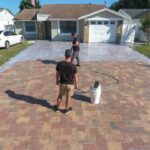Pavers are versatile and durable for enhancing outdoor spaces, whether driveways, patios, or walkways. However, like any exterior surface, pavers need proper maintenance to retain their functionality and beauty. One crucial aspect of paver maintenance is resealing. Over time, the original sealant on your pavers can wear off due to weather exposure, foot traffic, and general wear and tear. If you notice any of the following five signs, it may be time to reseal your pavers.
1. Fading or Dull Appearance
One of the most obvious signs that it’s time to reseal your pavers is their appearance. Pavers are sealed to preserve their natural color and vibrancy, but as the sealant deteriorates, the colors can fade or look dull. This is particularly noticeable in areas exposed to direct sunlight. UV rays can break down the sealant over time, causing the once-bright and vibrant pavers to lose their luster. If your pavers no longer look as fresh and colorful as they once did, resealing can restore their original appearance and protect them from further UV damage.
2. Water Absorption and Staining
A properly sealed paver surface repels water and resists stains. When the sealant wears off, you’ll notice that water no longer beads on the surface and instead gets absorbed into the pavers. This can lead to water damage, moss accumulation, or even cracks during freeze-thaw cycles if you live in a colder climate. Additionally, unsealed pavers are more prone to oil, grease, or dirt stains. If you notice that liquid spills are leaving marks or water is soaking into the surface, it indicates it’s time to reseal your pavers.
3. Weed Growth Between Pavers
While some weed growth between pavers can occur naturally due to environmental factors, excessive growth might signal that your paver joints are no longer adequately protected. Sealants act as a barrier, preventing seeds and dirt from settling into the spaces between your pavers. If you’re spending too much time pulling weeds or see vegetation thriving in the gaps, resealing can help stabilize the joint sand and significantly reduce the chance of weed growth.
4. Shifting or Loose Pavers
Over time, weather conditions and heavy use can cause the paver joints to loosen. Sand erosion between the joints, often caused by insufficient sealing, allows the pavers to shift or move out of place. This not only affects the aesthetic appeal but can also create an uneven and unsafe surface. Properly sealed pavers maintain stabilized joints and help prevent shifting or loosening. If you notice movement in your pavers, resealing and refilling the joints can restore their integrity.
5. Visible Cracks or Damage
Cracks or chips in your pavers could indicate that the sealant has failed to protect the surface from environmental elements. While pavers are durable, sealants add an extra layer of protection against moisture, freeze-thaw cycles, and wear. If you’re seeing more frequent signs of damage like cracks, chips, or erosion, it’s clear that you’re overdue for resealing. Timely resealing can prevent further degradation and extend the lifespan of your paver surfaces.
Why Resealing Matters
Resealing your pavers is more than just an aesthetic improvement; it’s a vital maintenance step that ensures your investment’s durability and long-term value. A fresh sealant acts as a shield, protecting your pavers from harsh elements, stains, and wear. Regular resealing not only preserves their color and structure but also reduces the need for costly repairs.
How Often Should You Reseal Your Pavers?
The frequency of resealing largely depends on the type of sealant used, the level of foot or vehicle traffic, and the local climate. On average, most pavers require resealing every 2-3 years. However, high-traffic areas or regions with extreme weather conditions may need more frequent upkeep. Schedule regular inspections to check for the above signs and ensure your pavers stay in excellent condition.
By looking for these telltale signs, you can determine when to reseal your pavers and prolong their beauty and functionality for years to come. Don’t wait until the damage is irreversible—act promptly to keep your outdoor spaces looking their best.



